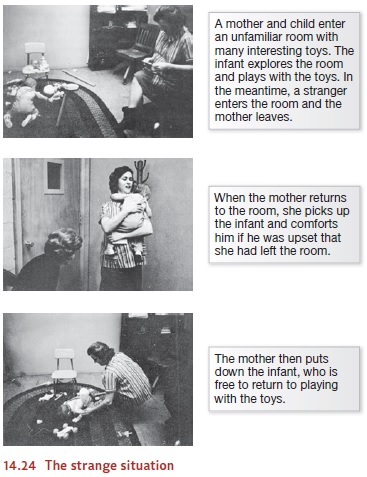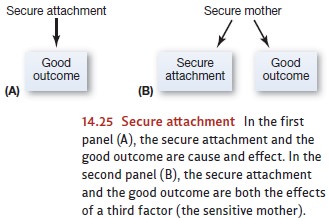Chapter: Psychology: Development
Differences in Attachment - Socioemotional Development in Infancy and Childhood
DIFFERENCES IN ATTACHMENT
Many
aspects of the attachment process are similar for all children. But we also
need to acknowledge that children differ in their patterns of attachment. To
study these differences, Mary Ainsworth and her colleagues developed a
procedure for assessing attachment—the so-called strange situation (Figure 14.24; Ainsworth & Bell, 1970;
Ainsworth, Blehar, Waters, & Wall, 1978). In this procedure, the
12-month-old child is brought into an unfamiliar room that contains many toys
and is allowed to explore and play with the mother present. After a while, an
unfamiliar woman enters, talks to the mother, and then approaches the child.
The next step is a brief separation—the mother leaves the child alone with the
stranger. After a few minutes, the mother returns and the stranger leaves.

This
setting is mildly stressful for most children, and by observing how the child
handles the stress, Ainsworth argued that we can determine the nature of the
child’s attachment. Specifically, Ainsworth and subsequent researchers argued
that children’s behavior in this setting will fall into one of four categories.
First, children who are securely attached
will explore, play with the toys, and even make wary overtures to
thestranger, so long as the mother is present. When the mother leaves, these
infants will show minor distress. When she returns, they greet her with great
enthusiasm.
Other
children show patterns that Ainsworth regarded as signs of insecure attachment.
Some of these children are described as anxious/resistant.
They do not explore, even in the mother’s presence, and become quite upset when
she leaves. Upon reunion, they act ambivalent, crying and running to her to be
picked up, but then kick-ing or slapping her and struggling to get down. Still
other children show the third pattern, called anxious/avoidant. They are distant and aloof while the mother is
present,and, although they sometimes search for her in her absence, they
typi-cally ignore her when she returns.
Children
in the fourth category show an attachment pattern called disorganized (Main & Solomon, 1990). Children in this group
seem tolack any organized way for dealing with the stress they experience. In
the strange situation, they sometimes look dazed or confused. They show
inconsistent behaviors—for example, crying loudly while trying to climb into
their mothers’ laps. They seem distressed by their moth-ers’ absence, but
sometimes move away from her when she returns.
In
healthy, middle-class families, roughly 60% of the infants tested are
categorized as “secure,” 10% as “anxious / resistant,” 15% as “anxious
/avoidant,” and 15% as “disorganized” (van Ijzendoorn, Schuengel, &
Bakermans-Kranenburg, 1999). The proportion of chil-dren showing “secure”
attachment is lower in lower-income families and families in which there are
psychological or medical problems affecting either the parents or the children.
One study, for example, assessed children who were chronically undernourished;
only 7% of these were “securely attached” (Valenzuela, 1990, 1997). Likewise,
mothers who are depressed, neurotic, or anxious are less likely to have
securely attached infants (NICHD Early Child Care Research Network, 1997).
Many
theorists argue that a child’s attachment status shapes his social world in
important ways. In part, this claim derives from the notion of a secure base: A securely attached child
feels safe, confident,
and
willing to take initiative in a wide range of circumstances, and these traits
will open a path to new experiences and new learning opportunities. Moreover,
securely attached children usually have a more harmonious relationship with
their caregivers and are therefore better able to learn from them; this, too,
can lead to numerous advantages in months and years to come (cf. Bretherton,
1990).
In
addition, Bowlby argued that the attachment relationship provides the child
with an internal working model of
the social world. This model includes a set of beliefs about how people behave
in social relationships, guidelines for interpreting others’ actions, and
habitual responses to make in social settings. This model grows out of the
child’s relationship with a caregiver, and according to Bowlby, it provides a
template that sets the pattern for other relationships, including friendships
and even romances. Thus, for example, if the child’s attachment figure is
available and responsive, the child expects future relationships to be
similarly gratifying. If the child’s attachment figure is unavailable and
insensitive, then the child develops low expectations for future relationships.
A
number of studies have demonstrated that these working models of attachment do
seem to have important consequences. For example, children who are securely
attached at 1 year of age are more attractive to other toddlers as playmates in
comparison to chil-dren who were insecurely attached (B. Fagot, 1997; Vondra,
Shaw, Swearingen, Cohen,
Owens,
2001; also B. Schneider, Atkinson, & Tardif, 2001; R. A. Thompson, 1998,
1999). Likewise, children who were securely attached show more helping and
concern for peers (van IJzendoorn, 1997; also see DeMulder, Denham, Schmidt,
& Mitchell, 2000). Even more impressive, children who were securely
attached as infants are more likely, as teenagers, to have close friends
(Englund, Levy, Hyson, & Sroufe, 2000; Feeney & Collins, 2001; Shulman,
Elicker, & Sroufe, 1994) and are less likely to suffer from anxiety disorders
in childhood and adolescence (Warren, Huston, Egeland, & Sroufe, 1997).

Unmistakably,
then, a child’s attachment pattern when he is 1 year old is a powerful
predictor of things to come in that child’s life. But what is the mechanism
behind this linkage? Bowlby argued that secure attachment leads to an internal
working model that helps the child in subsequent relation-ships. If this is
right, then secure attachment is associated with later positive outcomes because
the attachment is what produces these
outcomes, as depicted in Figure 14.25A. However, other interpretations of the
data are possible. Imagine, for example, that a child has a sensitive and
supportive caregiver. This could lead both to secure attachment and to better adjustment later on. In
this case, too, we would expect secure attachment to be associated with good
adjustment later in life— but not because the attachment caused the later
adjustment; instead, they could be two different effects of a single cause
(Figure 14.25B).
The
cause-and-effect story is further complicated by the fact that someone’s
attach-ment pattern can change. Overall, attachment patterns tend to be
consistent from infancy all the way to adulthood (Fraley, 2002)—and so, for
example, a child who seems securely attached when first tested is likely to be
classified the same way when assessed months (or even years) later. Even so,
they may change, especially if there is an important change in the child’s
circumstances, like a parent losing a job or becoming ill. Thus, even if the
1-year-old’s attachment pattern does create a trajectory likely to shape the
child’s life, there is nothing inevitable about that trajectory, and this, too,
must be acknowledged when we try to think through how (or whether) a young
child’s attach-ment will shape life events in years to come (R. A. Thompson,
2000, 2006).
Related Topics